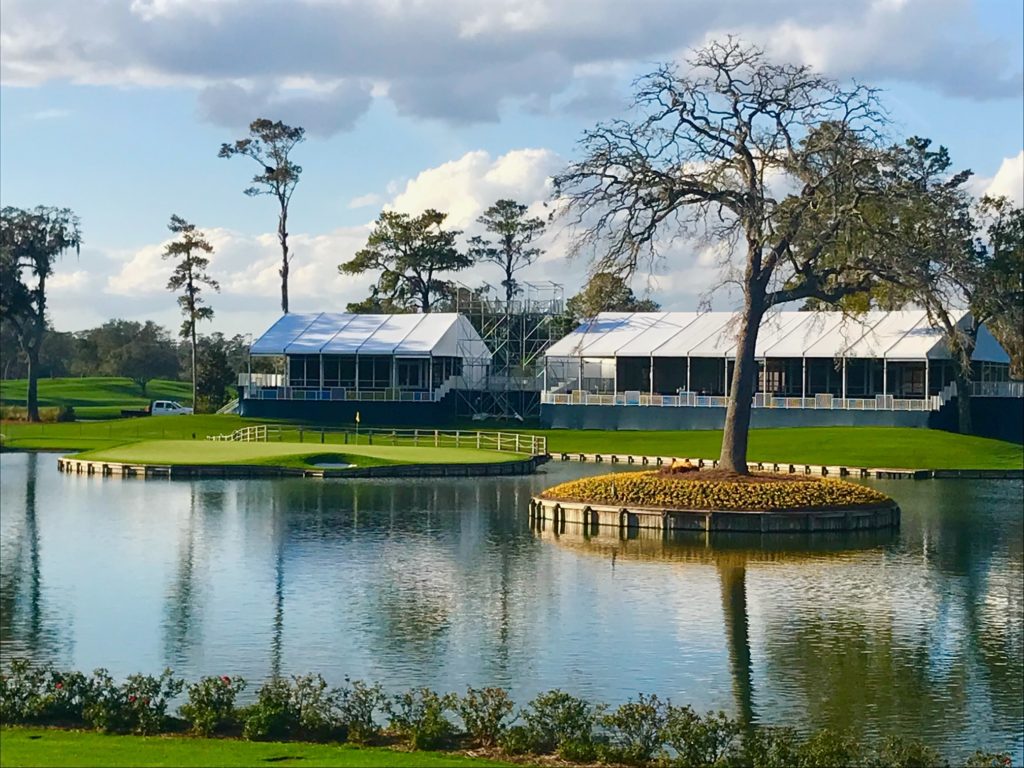
By: Grant Fraser, Senior Contributor
Not long after the pins have been pulled and the turf equipment stored away for the winter, the minds – and direction – of many Canadian golfers turn south.
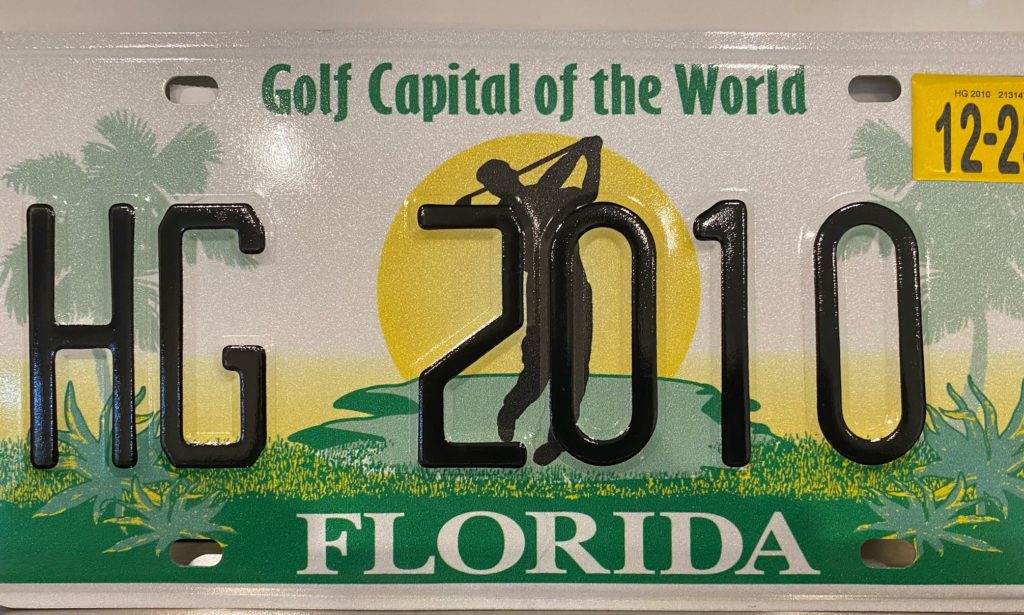
Florida License Plate
For avid sun and sand seekers, Florida’s beaches are among the best in the world, where living the “salt-life” is more than just an expression – it truly is a way of life. And then there are Florida’s golf courses. With over 1,200 layouts, it’s no wonder you’ll often see a Florida license plate bordered with the phrase “World’s Golf Capital” as you travel along Interstates 75 and 95.’
If you have travelled extensively along Florida’s vast coastline, you’ve likely seen signs welcoming you to the state’s Gulf Coast, Paradise Coast, or Treasure Coast, just to name a few. All are worthy destinations in their own right, but none can boast the moniker “First or Historic Coast”. That honour belongs to the northeastern beaches of Florida that extend from Amelia Island south to Palm Coast and the Flagler Beaches along the historic A1A highway. For golf enthusiasts, this100-plus mile stretch of Atlantic Ocean coastline encompasses over 50 accessible golf venues.
AMELIA ISLAND
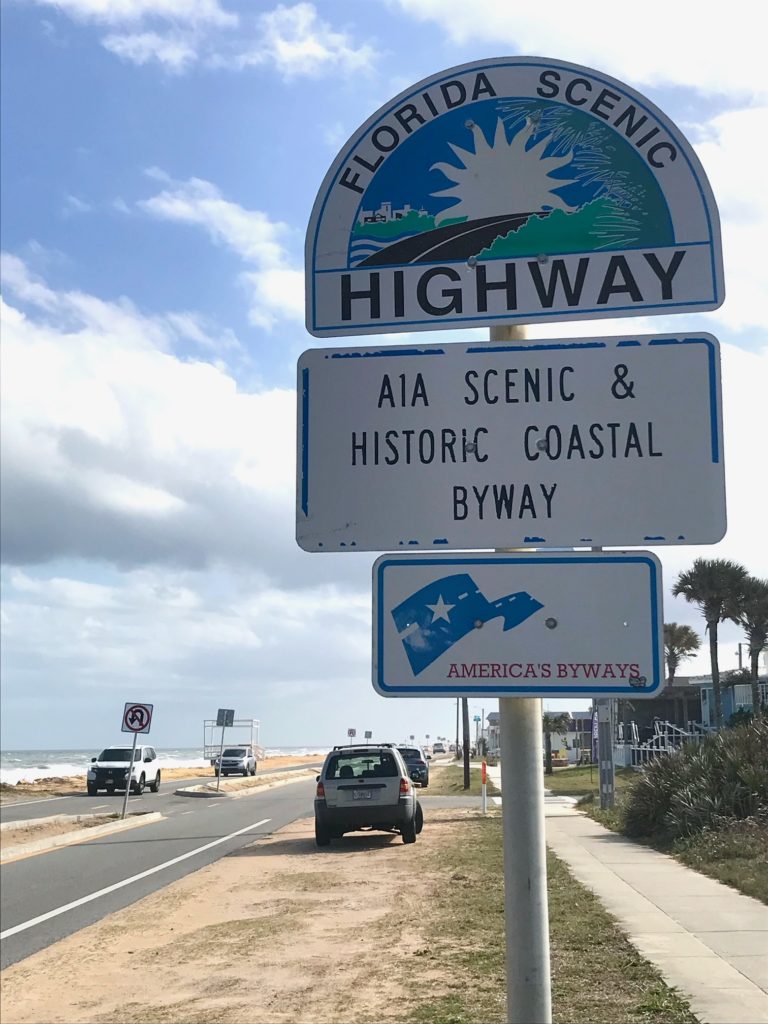
The historic A1A highway
Navigating from north to south, your First and Historic Florida Beach itinerary logically starts on what may be Florida’s best kept secret: Amelia Island. As the southernmost part of the Sea Islands Barrier chain, Amelia Island is nestled on the coastal border of Georgia and Florida. Similar in size and shape to Manhattan, this 13-mile-long, 2-mile-wide temperate island paradise is renowned for its unspoiled beaches, treelined-streets and laid-back vibe.
If you are unfamiliar with Amelia Island, you’re not alone, and the 40,000 residents of the island are content to keep it that way. That’s not to suggest visitors are not welcome. Quite the opposite. It’s just that Amelia Island is located off the beaten path and requires some foresight to incorporate into any Florida travel plan. Jacksonville, the nearest metropolitan area, is located 30 minutes southeast of the island which is only accessed by two bridges or a ferry across the St. Johns River. It’s Amelia Island’s pristine beaches and towering sand dunes, with their white and pink Appalachian quartz, that make this place so special.
While tourists are always welcome, Amelia Island is not “touristy.” Rather, it’s a place where you can find solitude. The beaches, extending for miles alongside the Atlantic Ocean, are never crowded. Not surprisingly, Amelia Island is a perennial mainstay on any Top 10 vacation or beach destinations list including Conde Nast Travelers Readers’ Choice Awards.
For history buffs, you could spend countless hours learning about the island’s history, rich with tales about explorers, soldiers, pirates, and real-estate barons. The indigenous Timucuan people were the island’s first residents, but over the last 400 years, Amelia has been fought over by nearly all of the colonial powers, earning the name “Isle of Eight Flags.” It is said that the French visited, the Spanish developed, the English named, and the Americans claimed it, which they did in 1817.
A good starting point is the Amelia Island Museum of History, followed by visits to Fort Clinch State Park, Historic American Beach, Florida’s first African American beach refuge, and a tour of the Historic District of Fernandina Beach, a 50-block area located at the north end of Amelia Island that can be experienced, on foot, bike, or car.
Now recognized on the National Register of Historic Places, the town of Fernandina was established in 1811 and named after King Ferdinand VII of Spain. It is this area of the island where you can walk the narrow, tree-lined streets named after the variety of indigenous hardwoods, including 150-year-old oaks draped with Spanish moss while savouring the Victorian-era mansions that remain intact as both family homes and charming Bed & Breakfast establishments.

Williams House
One such example is Williams House. Built in 1856 by an affluent Boston banker, Williams House now serves as a sumptuous B&B personifying 19th century Florida in all its grandeur. Regarded as one of the most historic homes in the town of Fernandina Beach, Williams House was recently designated a Florida Heritage Landmark site.

Oak Marsh at dusk
And then there’s the Amelia Island golf experience. Boasting 99 holes, the island features golf courses designed by the likes of Dye, Fazio and Palmer. Must plays include the 6,860-yard Amelia River Club, a Tom Jackson design noted for its wide fairways and proximity to the Fernandina Beach Municipal Airport and Oak Marsh, a 6,607-yard Pete Dye creation suitably named for its ageless, moss-covered oak trees and standalone marshland holes.
The Fernandina Beach Golf Club, owned by the City of Fernandina, is the island’s only 27-hole facility. Given its humble green fee, it’s also the most affordable golf here, so manage yo
ur playing condition expectations accordingly.
And finally, there is Little Sandy, a Beau Welling design featuring 10 holes ranging from 42 to 117 yards neatly woven around Red Maple Lake. Walking is the best -and only -way to fully appreciate this unique experience. Looking back, this was the most fun I have had on a golf course in recent memory.
My one regret about my time spent on Amelia Island was that it was too short. This is definitely a special place where you will want to linger for a while longer.
PONTE VEDRA
Upon crossing the bridge and reluctantly leaving the serenity of Amelia Island, your travels will lead you south to Ponte Vedra.
Most avid golfers would agree that the area’s kingpin is one of the game’s most preeminent addresses – TPC Sawgrass. Home to one of the most famous eighteen holes in the U.S., golf’s spotlight certainly shines on TPC Sawgrass during the first week of March, when the world’s best golfers convene to contest The Players Championship on Pete Dye’s diabolical Stadium Course.
Built in 1982, TPC Sawgrass is the brainchild of former PGA Tour commissioner Deane Beman, who paid one dollar ($1) for over 415 acres of gator-infested swampland that is now considered one of golf’s most feared and revered designs. His vision was simple: Build a ‘college bowl game’ atmosphere for golf.
While the golf course rightfully attracts most of the attention, be sure to include a wander through the Mediterranean-inspired, 77,000 sq. ft. clubhouse as part of your TPC Sawgrass experience. As you enter through the grand lobby, you are greeted by one of TPC’s friendly Storytellers, who are more than happy to take you on a tour of the clubhouse where you’ll see plenty of golf artwork, The Presidents Cup and FedEx Cup trophies, and the original $1 cheque Commissioner Beman paid to the Fletcher brothers for the property. There is also a $100 bill on display that came from the naysayers at the old Sawgrass Country Club, who bet Beman would never fulfill his dream and complete his “course in the swamp.”

Clubhouse TPC Sawgrass

17th Hole PC Sawgrass – Stadium
ST. AUGUSTINE
After fully immersing yourself in all that TPC Sawgrass has to offer, continue south to St. Augustine, the oldest city in the U.S. dating back to 1513 when Spanish explorer Juan Ponce de Leon first arrived in his adventurous search for the Fountain of Youth. Several years later, in the area now known as St. Augustine, General Pedro Menendez de Aviles and a thousand Spanish settlers set foot on the sandy shores on September 8, 1565.

Historic St. Augustine
Fast forward a few centuries, and the area’s proud Hispanic culture and history prevail, making St. Augustine the oldest, continuously occupied European settlement in the United States. A walk along the brick-paved streets will reveal one of the city’s 60 historic sites, including the Mission Nombre de Dios, the actual location where Pedro Menendez de Aviles and the Spanish settlers celebrated the first Mass and Thanksgiving in the U.S., and the Castillo de San Marcos, the oldest masonry fort in the U.S.
In addition to its quaint neighbourhoods and historically significant sites, St. Augustine is renowned for its eclectic and diverse restaurants. Among the many senses tantalized by St. Augustine is taste. Ask any of the fortunate few Floridians who call this home, and they’ll tell you this is a foodie paradise renowned for its mix of authentic Spanish and seafood cuisine.
For years, St. Augustine has been home to the World Golf Hall of Fame and Museum (WGHoF). After a 25-year run, the WGHoF is relocating to Pinehurst, N.C. With an anticipated opening date in 2024, it will continue to honour golf’s rich history and traditions by improving on what is already an informative and interactive experience for all who visit. More than 4,000 golf artifacts will continue to be displayed in the new location, tastefully showcasing the memories of the game.

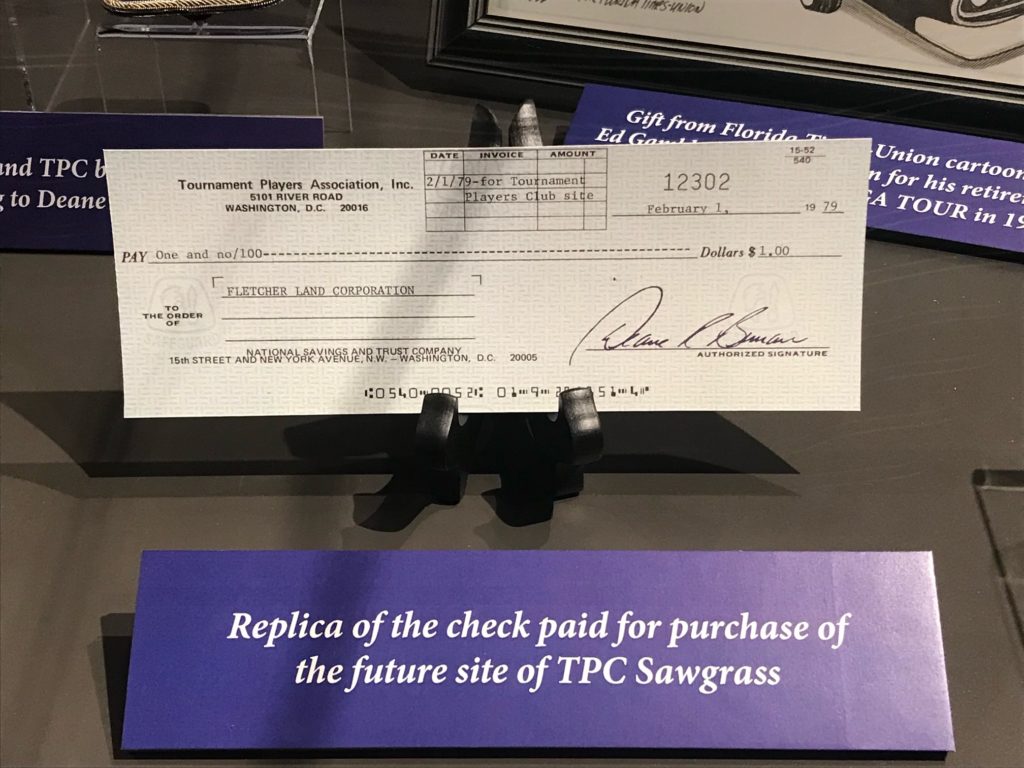
While the WGHoF may be relocating, the two “official” onsite golf courses, the King & Bear and Slammer & Squire, aren’t going anywhere. The former is the only golf course in the world designed in collaboration between legends Arnold Palmer and Jack Nicklaus. Architect Bobby Weed crafted the latter alongside golf greats Sam Snead (the “Slammer”) and Gene Sarazen (the “Squire”). Both are worth playing and have previously been listed among Golf Digest’s Top 75 Golf Courses in Florida.
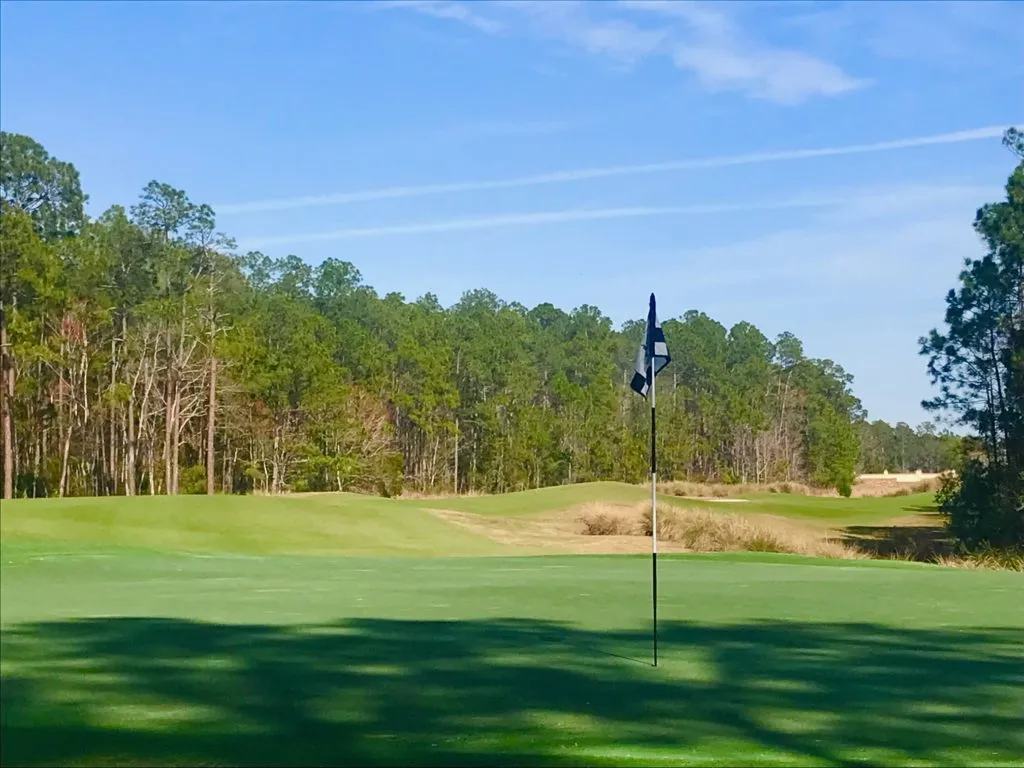
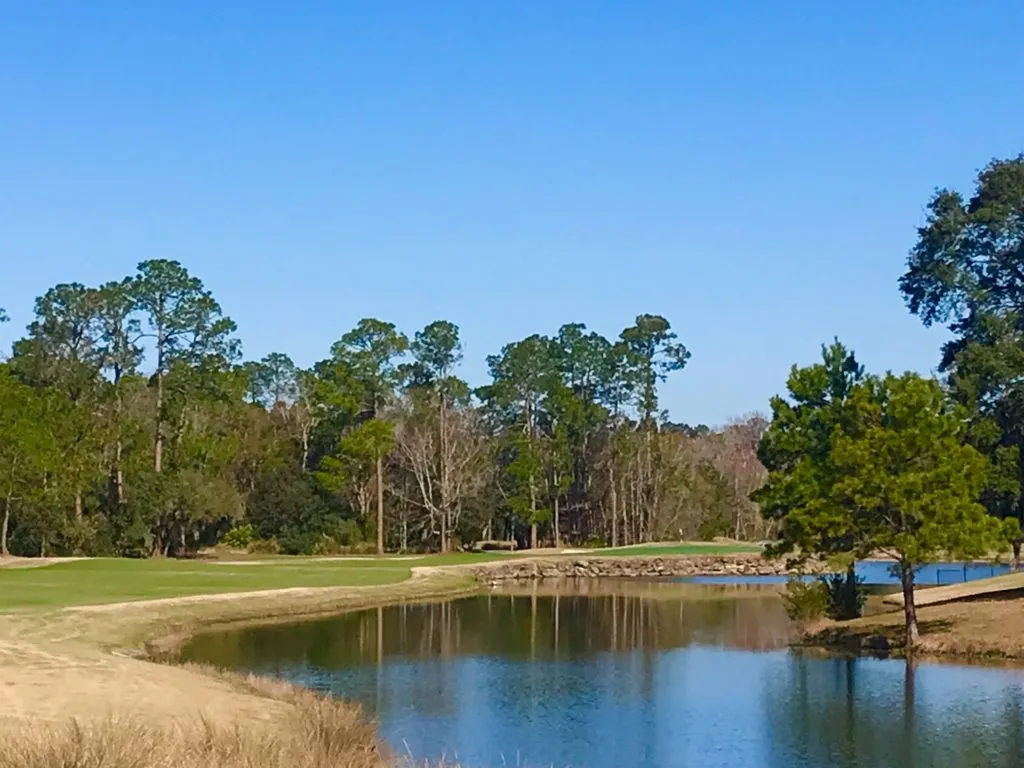
THE PALM COAST & FLAGLER BEACHES
A few miles south of St. Augustine along the Palm Coast is the Hammock Beach Golf Resort and Spa, appropriately located at 200 Ocean Crest Drive. Featuring every amenity imaginable, the resort is remotely situated on an unspoiled expanse of beach adjacent to the warm waters of the Atlantic Ocean. Whether you are here to relax or partake in its multitude of activities, Hammock Beach is well deserving of all the accolades it receives.
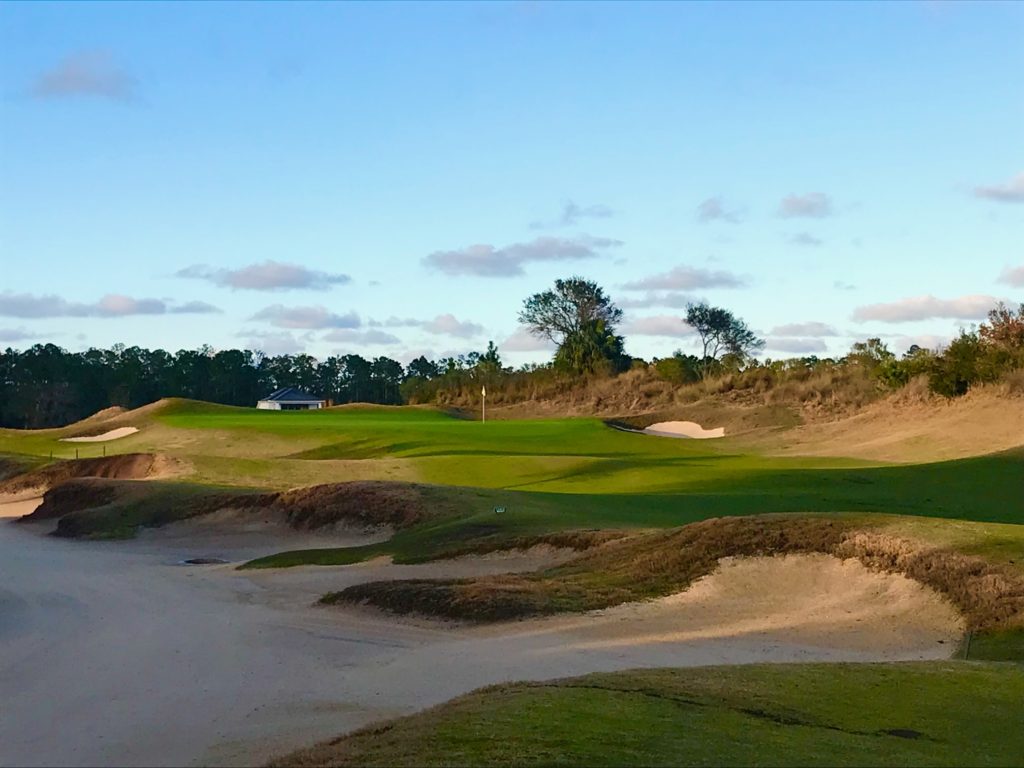
Watson’s Conservatory Course
If you’ve decided to come for the golf experience, you’ve made an excellent decision. Golf aficionados have a choice between the Jack Nicklaus Signature Design Ocean Course or the Tom Watson Signature Design Conservatory Course.
With six holes running parallel to the Atlantic Ocean, it is the four finishing holes of the 7,176-yard Ocean Course that generate the most post-round conversation among guests. It was Nicklaus himself who coined the phrase, “The Bear Claw”, as the descriptor for this collection of holes he considers to be some of his best and most memorable work. That says a lot, considering Nicklaus’ ubiquitous golf design repertoire.
Not to be outdone, Watson’s Conservatory Course is equally spectacular. Don’t be misled by its inland location -the course has both links and parkland style features with desert-style grasses and flared bunkers. Measuring a formidable 7,750 yards from the back tees, I enjoyed the playability and flow of every hole. There was no guess work involved, as what you saw from the tee dictated how the hole should be played. No gimmicks or unfair surprises -just an outstanding golf experience.

Spectacular Florida sunsets
Inventors Thomas Edison and Henry Ford, two of the most intelligent men in American history, spent their winters in Florida. So did Henry Flagler whose namesake adorns many roads and landmarks along the northeast coast of the state. These three American business pioneers knew a great thing when they saw one – and trading the snow and cold of the north for the palm trees, tropical breezes, and sandy beaches undoubtedly qualified. Within three hours from Toronto or Montreal, it’s easy to picture oneself strolling along Amelia Island’s cobblestone streets, dining at one of St. Augustine’s delectable waterfront restaurants, teeing it up at TPC Sawgrass, or enjoying the sand and surf at Hammock Beach.
All of this and more awaits those who come for the golf and to cherish the history along the shores of Florida’s First and Historic Coast.
Fast Facts
Getting There:
Air Canada and WestJet offer regular flights from Toronto and Montreal to Jacksonville and Orlando. For more information visit www.aircanada.com or www.westjet.com
Great Places to Eat:
Williams House (Amelia Island) – www.williamshouse.com
World Golf Village Renaissance St. Augustine Resort – www.marriott.com
Hammock Beach Golf Resort & Spa – www.hammockbeach.com
Amelia Island
Café Karibo – www.cafekaribo.com
First Love Brewing – www.firstlovebrewing.com
Salty Pelican – www.thesaltypelicanamelia.com
Ponte Vedra
Caddy Shack Restaurant – www.mbcshack.com
St. Augustine
Catch 27 – www.catchtwentyseven.com
Flagler Beach
Oceanside Bar and Grill – www.oceansideflagler.com
Best Way to Book a Tee Time:
Florida’s First Coast of Golf – www.florida-golf.org
World Golf Village and World Golf Hall of Fame & Museum:

